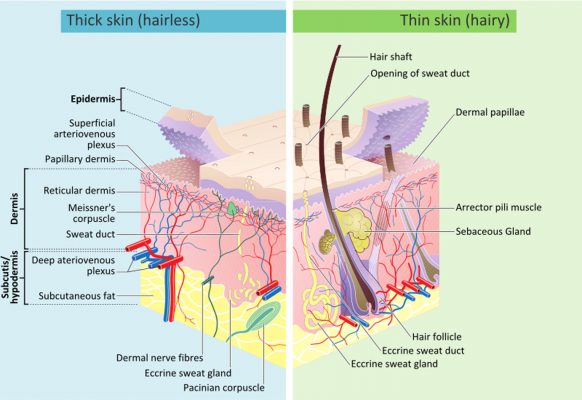By Taylor Graham
Editors Note: According to an article in Wikipedia, skin cancers are cancers that arise from the skin. They are due to the development of abnormal cells that have the ability to invade or spread to other parts of the body. There are three main types: basal-cell skin cancer, squamous-cell skin cancer, and melanoma.
The first two together along with a number of less common skin cancers are known as nonmelanoma skin cancer. Basal-cell cancer grows slowly and can damage the tissue around it but is unlikely to spread to distant areas or result in death. It often appears as a painless raised area of skin, that may be shiny with a small blood vessel running over it or may present as a raised area with an ulcer. Squamous-cell cancer is more likely to spread. It usually presents as a hard lump with a scaly top but may also form an ulcer.
Melanomas are the most aggressive. Signs include a mole that has changed in size, shape, color, has irregular edges, has more than one color, is itchy or bleeds.
People with nonmelanoma cancers still get sunburned due to wrong use of skin protection
A recent study by researchers at Johns Hopkins concludes that a substantial number of people with a history of the most frequent kind of nonmelanoma skin cancers still get sunburned at the same rate as those without previous history, probably because they are not using sun-protective methods the right way or in the right amounts.
The findings, which were based on self-reporting of sunburn and sun protection practices gathered from the National Health Interview Survey, urge skin doctors and other health care providers to better educate their patients about protective skin care practices, especially for those with history of nonmelanoma skin cancer.
The findings were published in May ahead of print in the Journal of the American Academy of Dermatology.
“It is important to look at how patients are currently practicing sun protection and what they are doing that is not very effective,” says Anna Chien, MD, co-director of the Cutaneous Translational Research Program in the Department of Dermatology at the Johns Hopkins University School of Medicine. “Only then can we make strides in helping patients improve their sun protective practices by ensuring they do them the correct way.”
13 million white non-Hispanic people in the U.S. have a history of nonmelanoma cancer
Sun exposure is the leading cause of nonmelanoma skin cancers, and treatment is estimated to cost $4.8 billion in the U.S. annually. In the United States, Chien says, approximately 13 million white non-Hispanic individuals have a history of at least one type of nonmelanoma skin cancer, including basal cell and squamous cell cancers, putting them at a well-documented higher risk for subsequent nonmelanoma skin cancer. For example, studies show that 40 percent of those with a history of basal cell carcinoma are diagnosed with another lesion within five years.
Nearly 35, 000 non-Hispanic white people studied
For the new study, investigators analyzed self-reported survey results about sun protective practices from 758 people with previous nonmelanoma skin cancer and from 34,161 people without a history of skin cancer. The study focused on non-Hispanic whites, the population most affected by nonmelanoma skin cancer. Of the people without history, 18,933 were female and 15,228 were male, and of those with history, 390 were female and 368 were male.
The researchers defined protective practices as using sunscreen when going outside on a sunny day for more than an hour, wearing long sleeves or a wide-brimmed hat, and staying in the shade when outside on a sunny day for more than one hour. They defined sun avoidance as not going out into the sun.
Overall, they concluded that 44.3 percent of people with nonmelanoma skin cancer history reported frequent use of shade, compared to 27 percent of people without a history of skin cancer, and 20.5 percent of those with a history of nonmelanoma skin cancer wore long sleeves, compared to 7.7 percent of those with no history.
Additionally, 26.1 percent of those with a history of nonmelanoma skin cancer said they wore a wide-brimmed hat when outside in the sun, compared to 10.5 percent of people without a history, and 53.7 percent of those with a history of nonmelanoma skin cancer said they wore sunscreen, compared to 33.1 percent of those without a history.
67% of 18-39-year-olds with skin cancer reported sunburn due to inadequate protection
Moreover, 44.7 percent of those with a history of nonmelanoma skin cancer reported using more than one form of sun protection, while only 19.4 percent of those without a history of nonmelanoma skin cancer said they did so.
Multimodality, the use of multiple skin-protective practices at a time, was associated with lower odds of sunburn. It also offers a highly beneficial approach to those with previous nonmelanoma skin cancer, says Chien.
Most importantly, the researchers say, was the finding that although people with previous nonmelanoma skin cancer tend to use one or all of the protective practices, there was not a significant difference in reporting of sunburn compared to those without a history — 29.7 percent versus 40.7 percent.
This means, Chien says, that although those with a history of skin cancer are proactively using protective methods, they may not be doing so effectively, especially among younger patients. Approximately two-thirds (66.9 percent) of individuals ages 18 to 39 reported sunburn.
Chien says that while sunscreen was the most common use of sun protection reported by participants, it was not associated with lower rates of sunburn in those with previous nonmelanoma skin cancer. While noting that self-reports, such as those on which the study is based, are not entirely reliable, the disconnect among those who use sunscreen and still get burned may occur because individuals are not applying sunscreen effectively. Explaining the correct ways — such as how much and how often — to apply sunscreen to patients is key, says Chien.
Physicians need to educate patients on the most optimal way to protect themselves
“These results suggest that physicians need to go the extra step in educating patients on the most optimal way of utilizing sun protection methods. Public health messages should also emphasize not only sun protection but how to do it correctly,” Chien says.
The researchers caution that although the data were pulled from a national survey, the results are self-reported and therefore may have some bias. In addition, Chien says, nonmelanoma skin cancer tends to be considered less important than melanoma and is thus underreported.
“The bottom line is that people should be using multiple forms of skin protective practices,” says Chien. “That means incorporating shade or sun avoidance into a daily routine, or wearing a wide-brimmed hat while also applying sunscreen correctly.”
Additional authors include Alexandre H. Fischer, Timothy S. Wang, Gayane Yenokyan and Sewon Kang, all of the Johns Hopkins University School of Medicine.
This publication was made possible in part by the Dr. Thomas Provost Young Investigator Fund in the Johns Hopkins Department of Dermatology; the Dean’s Summer Research Fund in the Johns Hopkins University School of Medicine; and the Johns Hopkins Institute for Clinical and Translational Research.
These were funded by the National Center for Advancing Translational Sciences, a component of the National Institutes of Health (NIH), and NIH Roadmap for Medical Research. Funding for the statistical analysis was supported in part by the National Center for Research Resources and the National Center for Advancing Translational Sciences of NIH
About Johns Hopkins Medicine:
Johns Hopkins Medicine (JHM), headquartered in Baltimore, Maryland, is a $7.7 billion integrated global health enterprise and one of the leading academic health care systems in the United States.
JHM unites physicians and scientists of the Johns Hopkins University School of Medicine with the organizations, health professionals and facilities of The Johns Hopkins Hospital and Health System. JHM’s vision, “Together, we will deliver the promise of medicine,” is supported by its mission to improve the health of the community and the world by setting the standard of excellence in medical education, research and clinical care.
Diverse and inclusive, JHM educates medical students, scientists, health care professionals and the public; conducts biomedical research; and provides patient-centered medicine to prevent, diagnose and treat human illness.
JHM operates six academic and community hospitals, four suburban health care and surgery centers, and more than 39 primary and specialty care outpatient sites under the umbrella of Johns Hopkins Community Physicians. JHM extends health care into the community and globally through Johns Hopkins Home Care Group, Johns Hopkins Medicine International and Johns Hopkins HealthCare.
The Johns Hopkins Hospital, opened in 1889, has been ranked number one in the nation by U.S. News & World Report for 22 years of the survey’s 26-year history. For more information about Johns Hopkins Medicine, its research, education and clinical programs, and for the latest health, science and research news, visit: www.hopkinsmedicine.org







